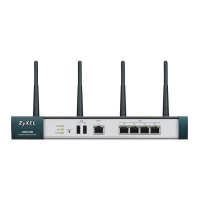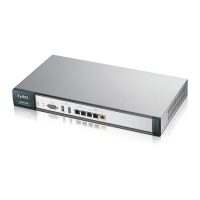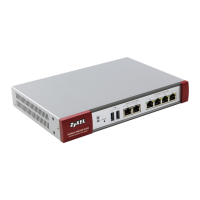Chapter 7 Trunks
UAG CLI Reference Guide
76
7.3 Trunk Commands Input Values
The following table explains the values you can input with the interface-group commands.
7.4 Trunk Commands Summary
The following table lists the interface-group commands. You must use the configure
terminal
command to enter the configuration mode before you can use these commands. See
Table 30 on page 76 for details about the values you can input with these commands.
Table 30 interface-group Command Input Values
LABEL DESCRIPTION
group-name A descriptive name for the trunk.
The name cannot start with a number. This value is case-sensitive.
interface-
name
The name of an interface, it could be an Ethernet, PPP, VLAN or bridge interface. The possible
number of each interface type and the abbreviation to use depends on the UAG model.
See Table 13 on page 55 for detailed information about the interface name.
num The interface’s position in the trunk’s list of members <1..8>.
<CR> Carriage Return (the “enter” key).
Table 31 interface-group Commands Summary
COMMAND DESCRIPTION
show interface-group {system-default|user-
define|group-name}
Displays pre-configured system default trunks, your own user
configuration trunks or a specified trunk’s settings.
[no] interface-group group-name Creates a trunk name and enters the trunk sub-command mode where
you can configure the trunk. The no command removes the trunk.
algorithm {wrr|llf|spill-over} Sets the trunk’s load balancing algorithm.
exit Leaves the trunk sub-command mode.
flush Deletes a trunk’s interface settings.
interface {num|append|insert num}
interface-name [weight <1..10>|limit
<1..2097152>|passive]
This subcommand adds an interface to a trunk. Sets the interface’s
number. It also sets the interface’s weight and spillover limit or sets it
to be passive.
loadbalancing-index
<inbound|outbound|total>
Use this command only if you use least load first or spill-over as the
trunk’s load balancing algorithm.
Set either inbound, outbound, or total (outbound and inbound) traffic
to which the UAG will apply the specified algorithm. Outbound traffic
means the traffic travelling from an internal interface (ex. LAN) to an
external interface (ex. WAN). Inbound traffic means the opposite.
mode {normal|trunk} Sets the mode for a trunk. Do this first in the trunk’s sub-command
mode.
move <1..8> to <1..8> Changes a the interface order in a trunk.
[no] interface {num|interface-name} Removes an interface from the trunk.
system default-interface-group group-name Sets the UAG to first attempt to use the the specified WAN trunk.
[no] system default-snat Enables or disables Source NAT (SNAT). When SNAT is enabled, the
UAG uses the IP address of the outgoing interface as the source IP
address of the packets it sends out through the WAN interfaces.

